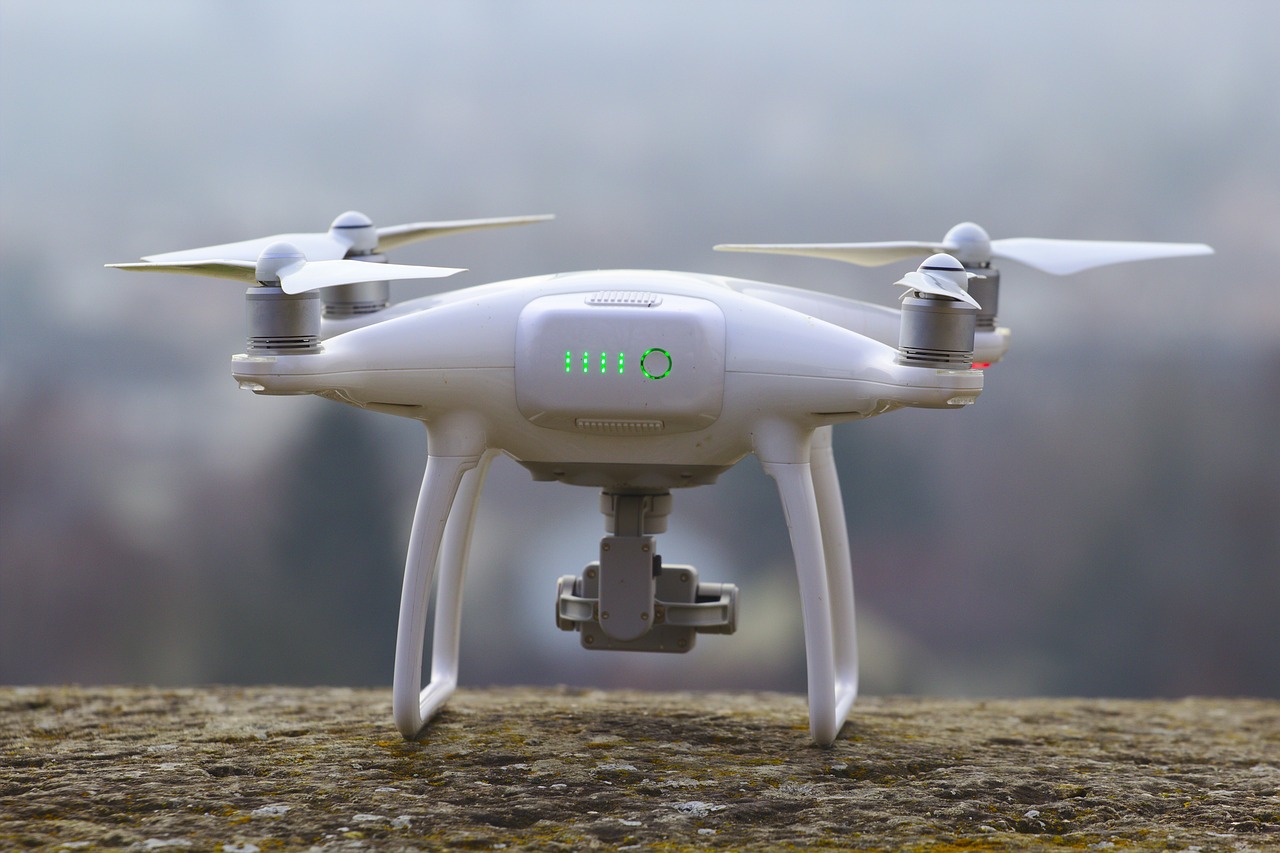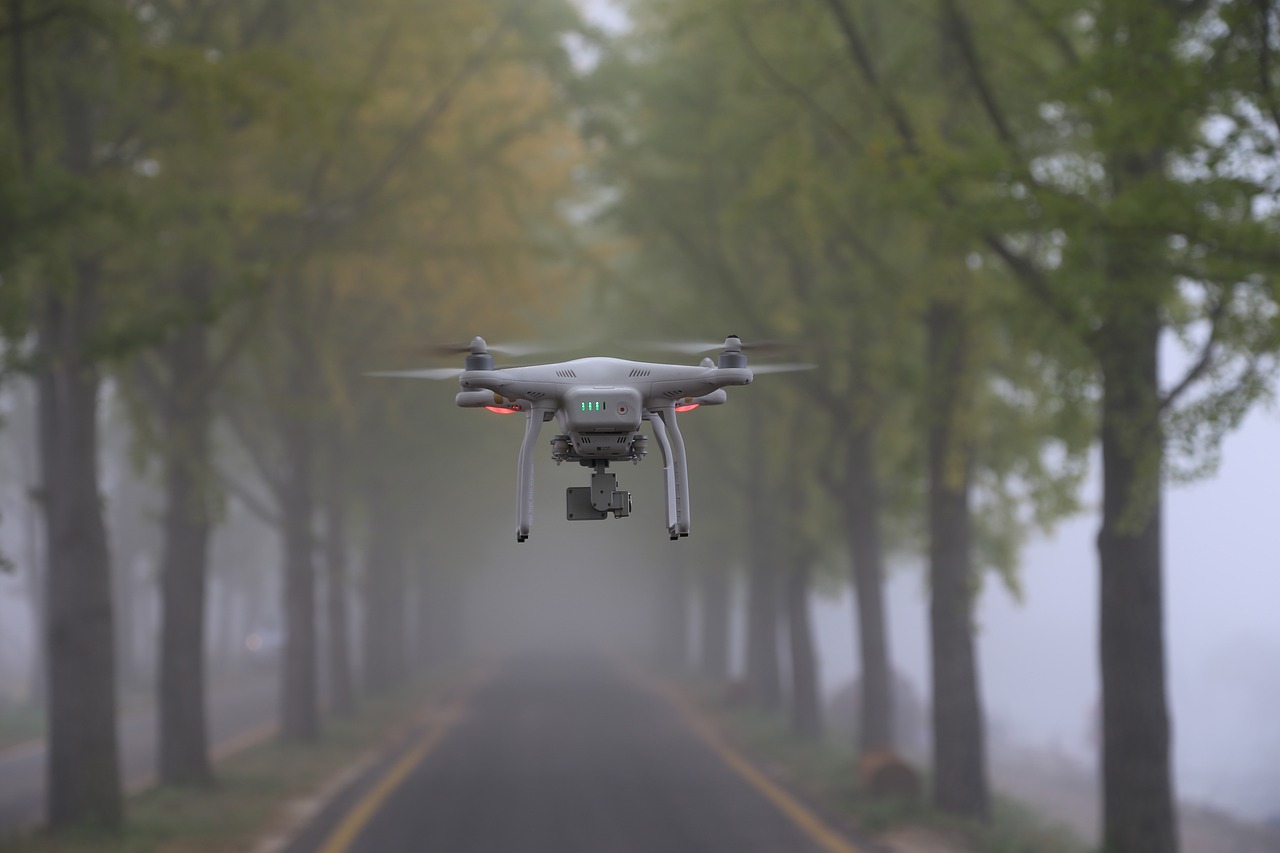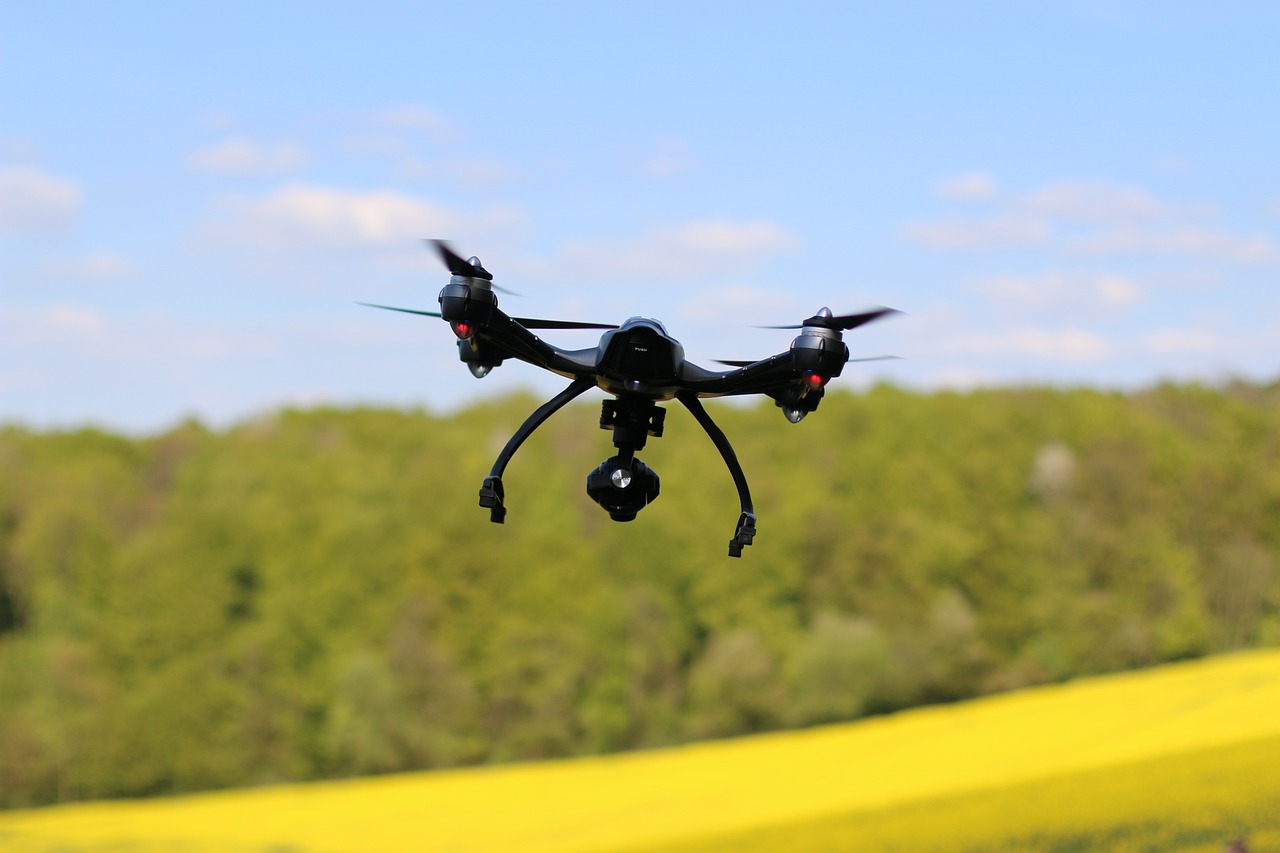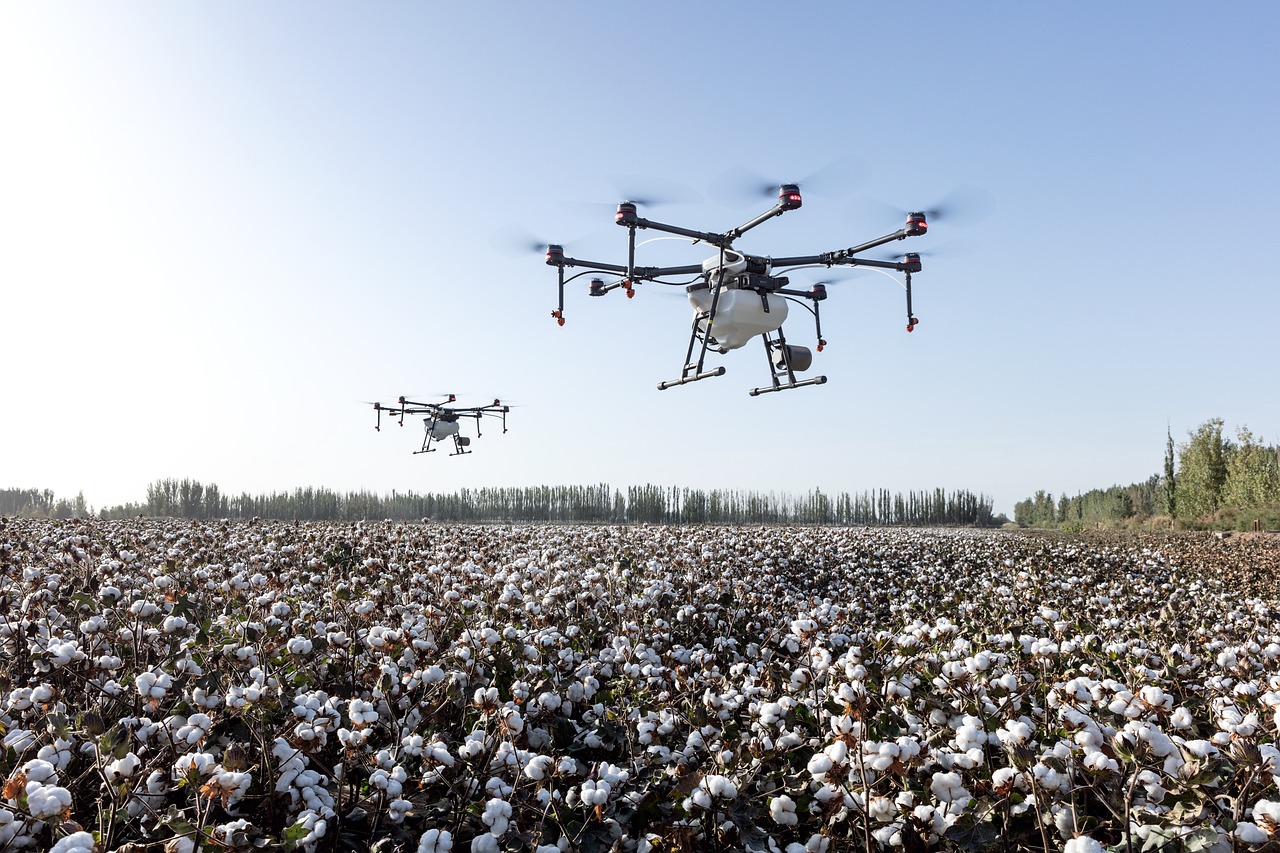Autonomous AI-Powered Reconnaissance Missions
In today’s rapidly evolving technological landscape, the advent of autonomous AI has sparked a revolution in the way reconnaissance missions are conducted. Imagine a world where machines can independently gather critical data, analyze it, and relay information without human intervention. This is not just a futuristic dream; it's becoming a reality. Autonomous AI systems are now capable of performing complex tasks that enhance both military and civilian operations, making them safer, more efficient, and incredibly precise.
The integration of AI into reconnaissance missions is akin to having a highly skilled assistant who never tires, never makes mistakes, and can operate under the most challenging conditions. These systems leverage advanced algorithms and machine learning to not only collect data but also interpret it in real-time. This capability is essential in situations where every second counts, such as during military operations or disaster responses.
One of the most exciting aspects of autonomous AI technology is its ability to operate in environments that are unsafe for humans. Imagine drones flying over hostile territories, gathering intelligence while keeping personnel out of harm's way. This not only reduces the risk to human life but also allows for a broader scope of data collection, providing a more comprehensive understanding of the operational area.
As we delve deeper into this article, we will explore how autonomous AI is transforming reconnaissance missions, starting with an overview of its core components and functionalities. We'll then examine its specific applications in military operations, including enhanced surveillance capabilities and data processing techniques. Additionally, we'll highlight successful case studies that illustrate these advancements in action.
But the implications of autonomous AI extend beyond military applications. Civilian operations, such as disaster response and environmental monitoring, are also benefiting from these technological advancements. As we explore these areas, we'll uncover the potential challenges and ethical considerations that come with deploying autonomous systems in sensitive environments. So, buckle up as we embark on this exciting journey into the world of autonomous AI-powered reconnaissance missions!
- What is autonomous AI? Autonomous AI refers to systems that can operate independently without human intervention, using advanced algorithms and machine learning to perform tasks.
- How does autonomous AI enhance reconnaissance missions? It improves data collection efficiency, reduces risk to human personnel, and enables real-time analysis of information.
- What are some civilian applications of autonomous AI? Civilian applications include disaster response, environmental monitoring, and infrastructure assessment.
- Are there any risks associated with autonomous AI in reconnaissance? Yes, potential risks include ethical concerns, privacy issues, and the reliability of AI decision-making in critical situations.

Overview of Autonomous AI Technology
Autonomous AI technology is revolutionizing the way we approach reconnaissance missions, both in military and civilian contexts. At its core, autonomous AI refers to systems that can operate independently, utilizing advanced algorithms and machine learning to interpret data and make decisions without human intervention. Imagine having a tireless assistant that can analyze vast amounts of information in seconds—this is what autonomous AI brings to the table.
The core components of autonomous AI technology include machine learning, computer vision, and sensor integration. Machine learning allows these systems to learn from data patterns, improving their performance over time. Computer vision enables them to process and understand visual data, which is crucial for tasks like identifying objects or assessing environments. Sensor integration involves combining data from various sources, such as cameras, radar, and GPS, to create a comprehensive understanding of the operational landscape.
One of the most exciting aspects of autonomous AI technology is its ability to integrate with existing systems. This means that instead of replacing traditional reconnaissance methods, autonomous AI enhances them. For instance, when deployed alongside drones or other surveillance tools, autonomous AI can analyze the data collected in real-time, providing actionable intelligence to operators on the ground. This integration not only boosts efficiency but also significantly reduces the workload on human personnel, allowing them to focus on strategic decision-making rather than data sifting.
Furthermore, the implications of autonomous AI technology extend beyond just efficiency. The ability to conduct reconnaissance missions autonomously translates to enhanced safety for human operatives. By utilizing AI systems in high-risk environments, we can minimize the exposure of personnel to dangerous situations. This is particularly vital in military operations where the stakes are high, and the margin for error is slim.
To visualize the impact of autonomous AI technology, consider the following table that outlines its key benefits:
| Benefit | Description |
|---|---|
| Efficiency | Speeds up data collection and analysis, allowing for quicker decision-making. |
| Safety | Reduces risk to human personnel by performing reconnaissance in hazardous environments. |
| Data Accuracy | Enhances the precision of data collection and reduces human error. |
| Scalability | Can be deployed across various platforms and missions, adapting to different operational needs. |
In summary, the overview of autonomous AI technology reveals a landscape filled with potential. As we continue to refine and develop these systems, the possibilities for their application in reconnaissance missions are virtually limitless. From military operations to civilian applications, autonomous AI is setting a new standard for efficiency, safety, and data collection capabilities.
- What is autonomous AI technology?
Autonomous AI technology refers to systems that can operate independently, using algorithms and machine learning to analyze data and make decisions without human input. - How does autonomous AI improve reconnaissance missions?
It enhances efficiency by speeding up data collection and analysis, improves safety by reducing human exposure to danger, and increases data accuracy. - Can autonomous AI be integrated with existing systems?
Yes, autonomous AI can be integrated with traditional reconnaissance tools, enhancing their functionality and effectiveness.

Applications in Military Operations
When we think about the battlefield of the future, it's hard not to get excited about the revolutionary impact of autonomous AI technology. This isn't just a buzzword; it's a game-changer that enhances military operations in ways we could only dream of a few decades ago. Imagine a world where drones equipped with advanced AI can scout enemy positions, gather intelligence, and relay critical information back to commanders in real-time—all while keeping human soldiers safe from harm. This is the reality that autonomous AI is creating, and it's reshaping the landscape of military reconnaissance.
One of the standout features of autonomous AI in military operations is its ability to provide improved situational awareness. In the chaos of combat, having a clear picture of the battlefield is paramount. AI systems can process vast amounts of data from various sources, including satellite imagery, ground sensors, and aerial reconnaissance, to create a comprehensive operational picture. This capability allows military leaders to make informed decisions quickly, potentially turning the tide of battle in their favor. With the integration of AI, the fog of war is becoming clearer.
Moreover, the reduction of risk to human personnel during reconnaissance missions cannot be overstated. Traditional reconnaissance often involves sending soldiers into potentially hostile territory, which carries inherent dangers. However, autonomous drones and robotic ground vehicles can perform these tasks without putting lives on the line. This shift not only preserves human life but also allows military forces to gather intelligence from areas that might otherwise be too risky to approach. The ability to deploy AI-powered systems in such scenarios is akin to having a virtual scout that can navigate the treacherous terrain without fear.
At the heart of military reconnaissance is the need for enhanced surveillance capabilities. Autonomous AI systems excel in this area, enabling real-time data collection and analysis. These systems can monitor vast areas, detect movement, and identify potential threats with a level of precision that is simply unattainable by human operators alone. For instance, a drone equipped with AI can fly over a designated area, scanning for unusual activity, and instantly alerting command centers if it detects anything suspicious. This capability not only improves response times but also enhances the overall effectiveness of military operations.
So, how does this all work? The secret lies in advanced data processing techniques employed by AI systems. These systems can analyze reconnaissance data at lightning speed, transforming raw information into actionable intelligence. For example, when a drone captures images of a potential enemy base, the AI can quickly analyze those images, identify key features, and even predict enemy movements based on historical data. This rapid analysis allows military leaders to stay one step ahead, making decisions based on the most current and relevant information.
Another crucial aspect of autonomous AI in military operations is its integration with existing systems. Modern military forces rely on a complex web of technologies, from satellite communications to ground-based sensors. Autonomous AI can seamlessly integrate with these systems, enhancing their functionality and effectiveness in reconnaissance missions. For instance, an AI-powered drone can communicate with ground troops, sharing real-time data and updates, which fosters better coordination and teamwork. This integration is not just about adding new technology; it's about creating a cohesive operational framework where every piece of equipment works together in harmony.
In the real world, the applications of autonomous AI in military operations have already yielded impressive results. Numerous case studies illustrate how these technologies have been successfully deployed in various missions, showcasing the practical benefits they offer. From counter-terrorism operations to border surveillance, the evidence is clear: autonomous AI is not just a theoretical concept; it is actively shaping military strategy and execution today.
- What are the primary benefits of using autonomous AI in military operations? The primary benefits include improved situational awareness, reduced risk to personnel, enhanced surveillance capabilities, and faster data processing and analysis.
- How does autonomous AI improve decision-making in military contexts? Autonomous AI analyzes vast amounts of data quickly, providing commanders with actionable intelligence that aids in making informed decisions.
- Can autonomous AI systems operate independently of human oversight? While autonomous AI can perform many tasks independently, human oversight is often still necessary to ensure ethical considerations and strategic alignment.

Enhanced Surveillance Capabilities
In the realm of modern warfare and intelligence gathering, provided by autonomous AI systems have revolutionized the way military operations are conducted. Imagine having a watchful eye in the sky, tirelessly collecting data and analyzing it in real-time, while human personnel can focus on strategic decision-making. This is not just a dream; it’s the reality that autonomous AI brings to reconnaissance missions.
These systems are equipped with advanced sensors and imaging technologies that allow them to capture high-resolution images and videos from various altitudes. With the integration of AI algorithms, these surveillance tools can differentiate between friend and foe, identify potential threats, and even predict movements based on historical data. The result? A level of situational awareness that was previously unattainable. For instance, during reconnaissance missions, drones powered by autonomous AI can cover vast areas in a fraction of the time it would take traditional methods, providing commanders with up-to-the-minute information.
Furthermore, the ability to process and analyze data on the fly is a game changer. Autonomous AI systems can sift through enormous amounts of data, identifying patterns and anomalies that human analysts might miss. This capability not only enhances the speed of intelligence gathering but also significantly improves the accuracy of the information being relayed back to decision-makers. It’s like having an army of analysts working around the clock, ensuring that no crucial detail goes unnoticed.
To better understand the impact of these enhanced surveillance capabilities, let’s break down some of the key features:
- Real-Time Data Collection: Autonomous AI systems can gather and transmit data instantaneously, allowing for quick assessments and timely responses.
- Advanced Target Recognition: Utilizing machine learning, these systems can learn to recognize specific targets, reducing the risk of misidentification.
- Autonomous Flight Paths: Drones can autonomously navigate complex environments, adapting their flight paths based on real-time data and obstacles.
Moreover, the integration of autonomous AI with existing military infrastructure enhances its effectiveness. These systems can communicate with ground forces, share intelligence seamlessly, and even coordinate with other unmanned systems for comprehensive operational coverage. This synergy not only maximizes efficiency but also minimizes the risks associated with human involvement in high-stakes environments.
As we look toward the future, the implications of these enhanced surveillance capabilities are profound. They promise to reshape military strategy and tactics, allowing for more informed decisions and ultimately saving lives. The question remains, how will military organizations adapt to this rapidly evolving technology, ensuring that they harness its full potential while addressing ethical considerations?
- What are the main advantages of using autonomous AI in surveillance? Autonomous AI enhances speed, accuracy, and the ability to process large amounts of data in real-time, providing superior situational awareness.
- How does autonomous AI differentiate between threats? Through advanced algorithms and machine learning, autonomous AI can analyze patterns and behaviors to identify potential threats accurately.
- Can autonomous AI systems operate in adverse weather conditions? Yes, many autonomous AI systems are designed to function in various environmental conditions, ensuring reliability in diverse scenarios.

Data Processing and Analysis
In the realm of autonomous AI-powered reconnaissance missions, stand out as crucial elements that transform raw information into actionable intelligence. Imagine a scenario where vast amounts of data pour in from various sensors and devices, each capturing unique perspectives of the environment. Without efficient processing, this data can become overwhelming, much like trying to drink from a fire hose. However, advanced AI algorithms are designed to tackle this challenge head-on, ensuring that the most relevant insights are extracted swiftly and accurately.
One of the key advantages of autonomous AI systems is their ability to process data in real-time. This means that as reconnaissance missions unfold, the AI can analyze incoming data streams from drones, satellites, and ground sensors almost instantaneously. By employing techniques such as machine learning and neural networks, these systems can identify patterns, detect anomalies, and even predict potential threats. For instance, if a drone captures images of an area, the AI can analyze those images to recognize vehicles, personnel, or unusual activities that might signify a security risk.
Furthermore, the integration of geospatial analysis enhances the effectiveness of data processing. AI systems can overlay various data sources, such as satellite imagery and geographic information systems (GIS), allowing for a comprehensive view of the operational landscape. This not only aids in situational awareness but also supports strategic planning. By visualizing data in a geographic context, military personnel can make informed decisions about troop movements, resource allocation, and potential engagement strategies.
To illustrate the capabilities of autonomous AI in data processing, consider the following table that outlines some of the key features and benefits:
| Feature | Benefit |
|---|---|
| Real-time Data Analysis | Immediate insights for timely decision-making |
| Pattern Recognition | Identifying threats and opportunities quickly |
| Geospatial Integration | Enhanced situational awareness and strategic planning |
| Automated Reporting | Reduced workload for human operators |
Moreover, the automation of data processing tasks not only accelerates the analysis phase but also minimizes the potential for human error. In high-stakes environments, where every second counts, relying on AI to sift through data can lead to more accurate and timely conclusions. This is particularly vital in military contexts, where the cost of mistakes can be catastrophic.
As we delve deeper into the capabilities of autonomous AI, it becomes clear that the future of reconnaissance missions is not just about collecting data but also about how effectively we can process and analyze it. The synergy between AI technologies and data analysis methodologies promises a new era of operational efficiency, one where human operators can focus on strategic decision-making rather than being bogged down by data overload.
- What is autonomous AI technology?
Autonomous AI technology refers to systems that can operate independently, using artificial intelligence to make decisions and perform tasks without human intervention.
- How does AI enhance reconnaissance missions?
AI enhances reconnaissance missions by providing real-time data analysis, improving situational awareness, and automating data processing, which reduces the risk to human personnel.
- What are some civilian applications of autonomous AI?
Civilian applications include disaster response, environmental monitoring, and urban planning, where AI can help collect and analyze data efficiently.

Integration with Existing Systems
Integrating autonomous AI with existing military systems is akin to adding a turbocharger to a high-performance engine; it enhances capabilities and boosts overall efficiency. This integration is not merely a technical upgrade but a transformational leap that redefines how reconnaissance missions are conducted. The synergy between autonomous AI and traditional systems allows for a seamless flow of information, making operations more fluid and responsive.
One of the primary benefits of this integration is the enhancement of communication networks. Autonomous AI can analyze data from various sources, including satellite imagery, drones, and ground-based sensors, and synthesize this information into actionable insights. Imagine a command center where data from multiple reconnaissance tools converges, processed in real-time by AI algorithms that highlight critical areas of interest. This capability not only speeds up decision-making but also reduces the cognitive load on human operators, allowing them to focus on strategy rather than sifting through mountains of data.
Moreover, the integration of autonomous AI with existing systems facilitates better resource allocation. For instance, during reconnaissance missions, AI can determine which assets are best suited for specific tasks based on real-time analysis. This can be particularly beneficial in dynamic environments where conditions change rapidly. By optimizing resource deployment, military operations can achieve greater efficiency and effectiveness, ensuring that personnel and equipment are utilized where they are needed most.
However, the integration process is not without its challenges. Compatibility issues between legacy systems and new AI technologies can arise, requiring careful planning and execution. Organizations must invest in training personnel to work with these advanced systems, ensuring they are equipped to leverage the full potential of autonomous AI. Furthermore, security concerns must be addressed, as the incorporation of AI raises questions about data integrity and vulnerability to cyber threats.
To illustrate the importance of this integration, consider the following table that outlines key areas where autonomous AI enhances existing military systems:
| Area of Integration | Benefits | Challenges |
|---|---|---|
| Data Analysis | Rapid synthesis of information leading to informed decision-making | Compatibility with legacy systems |
| Resource Allocation | Optimized deployment of assets based on real-time needs | Training requirements for personnel |
| Surveillance | Enhanced situational awareness through integrated data streams | Data security and integrity concerns |
In conclusion, the integration of autonomous AI with existing military systems represents a significant advancement in the execution of reconnaissance missions. By enhancing communication, optimizing resources, and providing real-time data analysis, this integration not only improves operational efficiency but also ensures that military personnel can operate in safer environments. As technology continues to evolve, the potential for even greater integration and collaboration between AI and existing systems is boundless, paving the way for a new era of military operations.
- What are the main benefits of integrating AI with existing military systems?
The main benefits include enhanced data analysis, optimized resource allocation, and improved situational awareness, all of which contribute to more effective reconnaissance missions.
- What challenges might arise during the integration process?
Challenges include compatibility issues with legacy systems, the need for personnel training, and concerns regarding data security and integrity.
- How does autonomous AI improve decision-making in military operations?
Autonomous AI processes and analyzes data in real-time, which allows military leaders to make informed decisions quickly and efficiently, reducing the cognitive burden on human operators.

Case Studies of Successful Missions
When we talk about autonomous AI-powered reconnaissance missions, the real magic happens in the field, where technology meets real-world challenges. Let's dive into some remarkable case studies that highlight the effectiveness and transformative power of autonomous AI in military operations.
One standout example is the use of unmanned aerial vehicles (UAVs) in the Middle East, where these AI-driven drones have been deployed for intelligence, surveillance, and reconnaissance (ISR) missions. In one mission, a fleet of UAVs was tasked with monitoring a highly volatile border area. The autonomous systems were able to cover vast stretches of terrain, collecting real-time data that was fed back to command centers. This enabled military personnel to make informed decisions almost instantaneously, significantly reducing the risk associated with traditional reconnaissance methods.
Another compelling case is the deployment of autonomous ground vehicles in urban settings. During a peacekeeping operation in a conflict zone, these vehicles were equipped with advanced sensors and AI algorithms that allowed them to navigate complex environments while gathering crucial intelligence. Unlike their human counterparts, these autonomous units could operate in dangerous areas without putting lives at risk. They successfully mapped out enemy positions and identified potential threats, all while maintaining a low profile, which is essential in sensitive operations.
Moreover, the integration of AI in reconnaissance missions has led to the development of sophisticated data processing techniques. For instance, during a joint military exercise, AI systems processed thousands of images captured by reconnaissance drones. The algorithms were able to identify patterns and anomalies, which would have taken human analysts days to discern. This capability not only speeds up data analysis but also enhances the accuracy of intelligence, providing commanders with actionable insights.
To illustrate the impact further, let's take a look at a table summarizing key case studies:
| Case Study | Location | Technology Used | Outcome |
|---|---|---|---|
| UAV Border Surveillance | Middle East | Unmanned Aerial Vehicles | Real-time data collection, improved situational awareness |
| Autonomous Ground Vehicles | Urban Conflict Zone | Ground Robotics | Risk reduction, enhanced intelligence gathering |
| Joint Military Exercise | Various | AI Data Processing | Faster analysis, actionable insights |
These case studies clearly demonstrate how autonomous AI not only enhances the efficiency of reconnaissance missions but also significantly improves safety for military personnel. The ability to gather and analyze data in real-time is a game-changer, enabling forces to respond swiftly and effectively to emerging threats.
As we look to the future, the potential applications of autonomous AI in reconnaissance missions are boundless. Whether it's monitoring conflict zones or assessing natural disasters, the lessons learned from these successful missions will undoubtedly pave the way for even more innovative solutions.
- What are autonomous AI-powered reconnaissance missions?
These missions utilize AI technology to conduct surveillance and gather intelligence without human intervention, enhancing efficiency and safety. - How does autonomous AI improve military operations?
It enhances situational awareness, reduces risks to personnel, and allows for real-time data collection and analysis. - Can autonomous AI be used in civilian applications?
Yes, autonomous AI is also effective in civilian contexts such as disaster response and environmental monitoring. - What are some challenges of using autonomous AI in reconnaissance?
Challenges include technical reliability, ethical considerations, and the need for robust cybersecurity measures.

Civilian Applications and Implications
In recent years, the integration of autonomous AI technology into civilian applications has opened a new frontier in how we approach reconnaissance missions. Imagine a world where drones equipped with advanced AI can autonomously survey disaster-stricken areas, assess environmental changes, and gather crucial data without endangering human lives. This isn't just a futuristic dream; it's happening now. The implications of these advancements are profound, affecting not only emergency responders but also environmental scientists, urban planners, and policymakers.
One of the most significant areas where autonomous AI is making waves is in disaster response scenarios. When natural disasters strike, every second counts. Autonomous AI systems can quickly deploy drones to impacted regions, providing real-time aerial imagery and data analysis. This capability allows first responders to assess damage more accurately and prioritize their efforts effectively. For instance, during a hurricane, AI-powered drones can map out flooded areas, identify blocked roads, and even locate survivors, all while human personnel are kept safe from potential hazards.
Moreover, autonomous AI is proving invaluable in environmental monitoring. As climate change continues to pose a significant threat to our planet, the need for effective data collection has never been more urgent. Autonomous systems can be deployed in remote or hazardous locations where human presence is limited or risky. They can gather data on wildlife populations, track deforestation rates, and monitor air and water quality. The data collected is then analyzed using sophisticated algorithms, providing insights that can drive conservation efforts and policy decisions.
| Application | Description | Benefits |
|---|---|---|
| Disaster Response | AI drones assess damage and locate survivors. | Increased safety for responders, faster assessment. |
| Environmental Monitoring | Data collection on wildlife and natural resources. | Enhanced conservation efforts, informed policy-making. |
| Urban Planning | Mapping and analyzing urban growth and infrastructure. | Improved resource allocation, sustainable development. |
However, with these advancements come challenges and ethical considerations. The use of autonomous AI in civilian applications raises questions about privacy, data security, and the potential for misuse. For example, while monitoring environmental changes is crucial, the data collected must be handled with care to protect sensitive information. Additionally, there's a need for clear regulations governing the deployment of autonomous systems in public spaces to ensure they are used responsibly and ethically.
As we look towards the future, the potential for autonomous AI in civilian applications is immense. By enhancing our capabilities in reconnaissance missions, we can not only improve our responses to disasters but also contribute to the ongoing fight against climate change. It's a delicate balance of leveraging technology for the greater good while ensuring that we remain vigilant about the implications of its use.
- What are the primary benefits of using autonomous AI in civilian applications?
Autonomous AI enhances efficiency, improves safety, and provides real-time data collection, which is essential in disaster response and environmental monitoring. - How does autonomous AI impact data privacy?
While autonomous AI can collect valuable information, it raises concerns about how that data is stored and used, necessitating strict regulations to protect privacy. - Can autonomous AI be used in urban planning?
Yes, autonomous AI can analyze urban growth patterns and infrastructure, helping planners make informed decisions for sustainable development. - What challenges does autonomous AI face in civilian applications?
Challenges include ethical concerns, data security, and the need for clear regulations to ensure responsible use.

Disaster Response Scenarios
When disaster strikes, whether it’s a natural calamity like an earthquake or a man-made crisis such as an industrial accident, the clock is ticking. Every second counts, and the need for rapid, accurate information becomes paramount. Enter autonomous AI technology, a game-changer in disaster response scenarios. Imagine a world where drones equipped with AI can swiftly navigate through wreckage, assess damage, and relay critical information to first responders. This technology not only enhances the speed of response but also significantly increases the safety of personnel on the ground.
One of the most compelling aspects of autonomous AI in disaster scenarios is its ability to operate in environments that are too dangerous for humans. For instance, after a major earthquake, traditional search and rescue teams may face obstacles like unstable buildings and hazardous materials. However, AI-powered drones can fly into these zones, capturing real-time data and providing a comprehensive overview of the situation. This capability allows emergency services to make informed decisions about where to deploy resources effectively, ultimately saving lives.
Moreover, autonomous AI systems can analyze vast amounts of data in a fraction of the time it would take a human team. Imagine a scenario where thousands of images from drones are processed to identify areas of highest need. AI algorithms can quickly pinpoint regions that require immediate attention, prioritizing rescue efforts based on factors such as population density and accessibility. This level of data-driven decision-making can significantly improve the efficiency of disaster response operations.
In addition to damage assessment, autonomous AI can also facilitate communication during crises. Utilizing advanced algorithms, AI systems can help coordinate between various agencies and organizations. For example, during hurricane evacuations, autonomous vehicles can be deployed to transport individuals to safety, ensuring that those in vulnerable situations receive assistance promptly. The integration of AI in these scenarios not only streamlines operations but also enhances overall situational awareness among response teams.
However, while the benefits are substantial, there are also challenges to consider. The deployment of autonomous AI in disaster response raises questions about data privacy and the ethical implications of using AI in sensitive situations. Ensuring that these technologies are used responsibly and effectively is crucial for maintaining public trust and achieving optimal outcomes.
In conclusion, the role of autonomous AI in disaster response scenarios is transformative. From improving situational awareness to enhancing the safety of responders, the technology is paving the way for a more efficient and effective approach to crisis management. As we continue to innovate and refine these systems, the potential to save lives and mitigate disaster impacts will only grow.
- How does autonomous AI improve disaster response?
Autonomous AI enhances disaster response by providing real-time data collection, analysis, and communication, allowing for quicker and more informed decision-making. - What types of disasters can benefit from autonomous AI?
Autonomous AI can be utilized in various disasters, including natural events like earthquakes and floods, as well as man-made crises such as industrial accidents. - Are there any ethical concerns with using AI in disaster scenarios?
Yes, there are concerns regarding data privacy and the ethical implications of deploying AI in sensitive situations, which need to be addressed to maintain public trust. - Can AI operate in dangerous environments?
Absolutely! AI-powered drones and vehicles can navigate hazardous areas where human responders may be at risk, ensuring safety while gathering vital information.

Environmental Monitoring
In today's rapidly changing world, the importance of cannot be overstated. As we face challenges like climate change, pollution, and habitat destruction, the need for effective data collection and analysis has become critical. Autonomous AI technology is stepping up to the plate, revolutionizing how we monitor our environment. Imagine a world where drones equipped with advanced sensors can fly over vast areas, collecting data on air quality, water levels, and wildlife populations without the need for human intervention. This isn't science fiction; it's happening right now!
One of the key benefits of using autonomous AI in environmental monitoring is its ability to gather data from hard-to-reach areas. For instance, in remote forest regions or disaster-stricken zones, deploying human teams can be risky and time-consuming. However, AI-powered drones can swiftly cover these terrains, capturing essential data while keeping human personnel safe. This technology allows for the continuous monitoring of ecosystems, providing real-time insights that are crucial for conservation efforts.
Moreover, the data collected through these autonomous systems can be processed and analyzed at an unprecedented speed. Advanced algorithms can sift through massive datasets to identify patterns and anomalies, enabling scientists to make informed decisions quickly. For example, if an AI system detects a sudden increase in pollutants in a river, it can alert authorities in real-time, prompting immediate action to mitigate the impact. This capability transforms how we respond to environmental threats, turning reactive measures into proactive strategies.
However, the integration of autonomous AI in environmental monitoring does come with its challenges. Issues such as data privacy, ethical considerations, and the need for robust regulatory frameworks must be addressed. As we harness the power of AI, it's crucial to ensure that these technologies are used responsibly and transparently. Collaboration between governments, tech companies, and environmental organizations is essential to develop guidelines that maximize the benefits of autonomous monitoring while minimizing potential risks.
To illustrate the impact of autonomous AI in environmental monitoring, let's take a look at some specific applications:
| Application | Description | Benefits |
|---|---|---|
| Wildlife Conservation | Drones monitor animal populations and habitats. | Real-time data helps prevent poaching and habitat loss. |
| Pollution Tracking | AI systems analyze air and water samples for contaminants. | Quick response to pollution incidents protects ecosystems. |
| Climate Change Research | Collects data on temperature changes, ice melt, etc. | Informs policy decisions and conservation strategies. |
As we continue to explore the potential of autonomous AI in environmental monitoring, it's essential to recognize that this technology is not just a tool but a partner in our efforts to protect the planet. By leveraging AI's capabilities, we can enhance our understanding of environmental issues and develop more effective solutions. The future of environmental monitoring is bright, and with autonomous AI, we are well-equipped to face the challenges ahead.
- What is autonomous AI in environmental monitoring?
It refers to the use of AI-driven systems, like drones and sensors, to collect and analyze environmental data without human intervention. - How does AI improve data collection?
AI can process large amounts of data quickly and identify patterns that may not be immediately obvious to human analysts. - Are there any risks associated with using AI for environmental monitoring?
Yes, issues such as data privacy, ethical concerns, and the need for regulation must be addressed to ensure responsible use of technology. - Can autonomous AI help in disaster response?
Absolutely! AI can assess damage and coordinate relief efforts more efficiently in disaster-stricken areas.
Frequently Asked Questions
-
What is autonomous AI technology?
Autonomous AI technology refers to systems that can operate independently, utilizing artificial intelligence to perform tasks without human intervention. This includes the ability to gather data, analyze it, and make decisions based on that information, which is crucial for reconnaissance missions.
-
How does autonomous AI enhance military operations?
In military operations, autonomous AI enhances efficiency by improving situational awareness, allowing for real-time data collection, and reducing risks to human personnel. It helps in making informed decisions quickly, especially in high-stress environments.
-
Can autonomous AI be integrated with existing military systems?
Absolutely! One of the key benefits of autonomous AI is its ability to integrate seamlessly with existing military systems. This integration enhances overall functionality and effectiveness, providing a significant boost to reconnaissance missions.
-
What are some successful case studies of autonomous AI in reconnaissance missions?
There are several case studies that highlight the success of autonomous AI in reconnaissance. These include missions where AI systems efficiently gathered intelligence in challenging environments, leading to improved operational outcomes and strategic advantages.
-
How is autonomous AI used in civilian applications?
In civilian applications, autonomous AI plays a vital role in areas such as disaster response and environmental monitoring. It helps assess damage after disasters and collects data for conservation efforts, making it a valuable tool for various humanitarian and environmental initiatives.
-
What challenges does autonomous AI face in reconnaissance missions?
While autonomous AI offers numerous benefits, it also faces challenges like data privacy concerns, the need for robust security measures, and the potential for technical failures. Addressing these challenges is crucial for maximizing the effectiveness of AI technologies in reconnaissance.



















